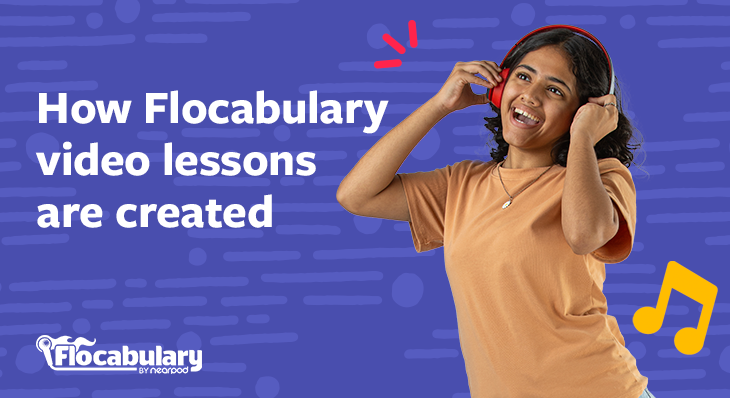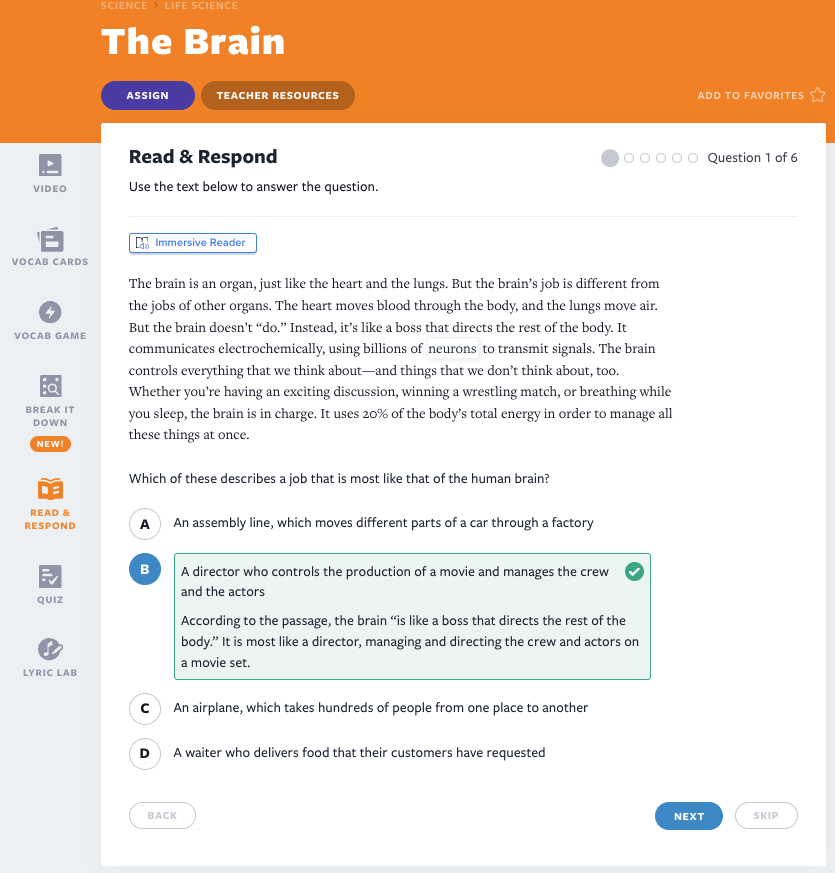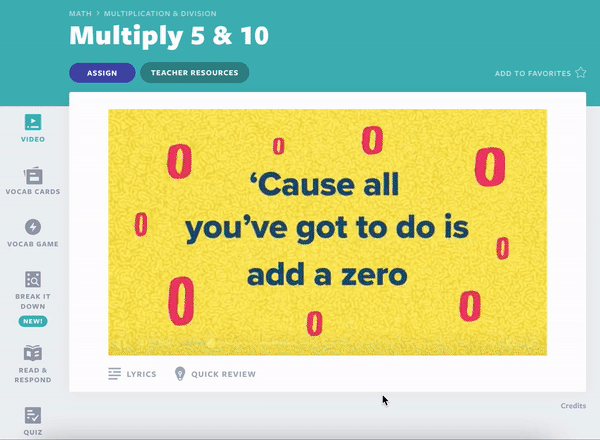
How Flocabulary video lessons are created
Flocabulary is equipped with a library of more than 1,300 standards-aligned hip-hop videos and lesson activities. With every lesson we create, our goal is to accelerate learning and vocabulary acquisition through genuinely rigorous and authentically engaging instructional experiences.
Since 2005, we’ve been utilizing the power of hip-hop to help students develop their vocabulary and reading comprehension skills. Hip-hop by nature is both sticky and wordy—with naturally memorable rhymes and 2-3 times more words per song than any other genre, it’s a powerful way to teach vocabulary. We embed key vocabulary terms into the lyrics of each video with ample context for students to uncover word meanings. These memorable vocabulary exposures are repeated throughout the Flocabulary lesson sequence at key moments, including through the Vocab Cards, Vocab Game, and Read & Respond. And it’s this repeated exposure to vocabulary that contributes to student reading comprehension ability.
But how are Flocabulary lessons made? What do we do to ensure authentic engagement without sacrificing rigor? Keep reading to learn how our lesson videos, like the one below, are created!
How Flocabulary video lessons are created
Learn about Flocabulary’s lesson creation process directly from the Flocabulary team. Watch the video below and keep reading to discover even more!
Step 1: Research
The lesson production process begins with our curriculum team. A curriculum writer reviews national and state standards, determines the proper grade range for a lesson, and identifies student learning objectives. They then add this information to a research document alongside extensive notes on how a particular topic is taught. This document guides the development of lesson activities such as our Quiz, Read & Respond, and Vocab Cards. It also helps us create lyricist notes—a concise outline of the content a rapper should cover in their lyrics, including a list of key vocabulary terms that must be included.
At the end of this stage, the curriculum team passes the lyricist notes on to our audio team. But, the curriculum writer assigned to the lesson isn’t done yet: They stay involved throughout the entire production process to ensure rigor, accuracy, and alignment to learning objectives.


Step 2: Audio
An audio producer and the curriculum writer work together to review and finalize the lyricist notes to make sure what’s included will be not only rigorous but also authentically engaging and will make a good song. Hip-hop has the power to connect with students on an emotional and personal level, all while packing in more words per song than any other genre. This makes it an ideal tool for teaching vocabulary and unlocking comprehension.
Once lyricist notes are finalized, the audio producer picks an instrumental that fits the tone of the song and selects one of our many talented rappers to work with. Using the notes as a guide, the rapper crafts a first draft of lyrics. The audio producer and curriculum writer on the lesson then review what’s been written, focusing on style, quality of rhymes, clarity, accuracy of content, grade-level appropriateness, and alignment to standards and learning objectives. The audio producer then shares feedback with the rapper, makes edits, and then sends the lyrics back for another review. Some songs require one or two rounds of edits, while others require more.
Once lyrics are approved, it’s time to record, mix, and master the song before it’s passed on to the video team.
Meet some of the talented artists working on Flocabulary’s videos!
Step 3: Video
Once a song is finalized, an art director takes over to decide what visual style best suits a lesson and guides the creation of a video to match the song. At Flocabulary, we take a unique approach to each video rather than relying on a set formula. We do this by working with a diverse range of illustrators, animators, video editors, and hosts who help us keep things unpredictable—and fun!
After an artist sends the first version of a video, our review process comes back into play. The curriculum writer and art director assigned to a lesson review the video for style, accessibility, accuracy, and alignment to standards and learning objectives. The art director then shares feedback and suggested edits with the artist. Every video undergoes the same review process—a process that can take months depending on the video.
After several rounds of edits and review, the video is ready to be finalized. A member of our video team adds subtitles and then prepares the final version for publishing.
Step 4. Lesson activity writing
While each video is being reviewed, the curriculum writer is working on creating the rest of the lesson sequence activities. Using the research document from Step 1, they write Vocab Cards, a Vocab Game, Break It Down questions, Read & Respond passages, and multiple-choice questions, as well as a Quiz and a custom printable activity. This work is passed on to a curriculum editor for review before our operations team publishes the final lesson.
This post outlines our Flocabulary lesson creation process at a high level—a process that differs slightly for Nearpod Original Videos and Flocabulary Mix Video Texts. Since no two lessons are exactly alike, our team often has to remain flexible to ensure that our approach best serves the topic being taught. This flexibility also helps us maintain a high bar for quality from a curriculum, audio, and visual perspective.

Start exploring Flocabulary’s lessons
At Flocabulary, we understand the value of creating content that is both engaging and rigorous. We’ve spent years refining our production process in order to ensure that what we create is unique, relevant to students, and standards-aligned. Every time you press play on a Flocabulary video or assign a lesson activity to your students, you can rest assured that the lesson has been thoughtfully created. From our curriculum team to our audio team to our rappers, video team, and visual artists, everyone who touches a Flocabulary lesson understands our mission: to accelerate learning and vocabulary acquisition through genuinely rigorous and authentically engaging instructional experiences. With that as our North Star, we’ve created a well-oiled production machine—one that keeps the needs of students and teachers at the center.
So, now that you know how each lesson is created, what will you teach next on Flocabulary?
New to Flocabulary? Teachers can sign up for a trial to access our lesson videos and assessment activities. Administrators can get in touch with us to learn more about unlocking the full power of Flocabulary through Flocabulary Plus.
